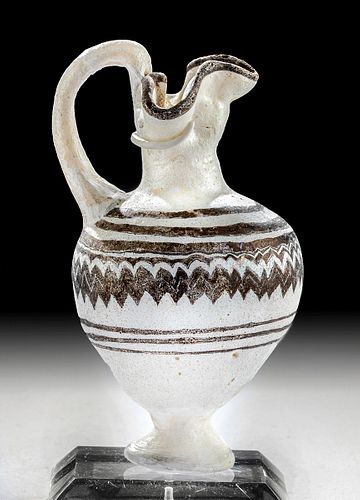Fine Greek Core-Formed Glass Oinochoe - White & Purple
Lot 22a
About Seller
Artemis Gallery
686 S Taylor Ave, Ste 106
Louisville, CO 80027
United States
Selling antiquities, ancient and ethnographic art online since 1993, Artemis Gallery specializes in Classical Antiquities (Egyptian, Greek, Roman, Near Eastern), Asian, Pre-Columbian, African / Tribal / Oceanographic art. Our extensive inventory includes pottery, stone, metal, wood, glass and textil...Read more
Categories
Estimate:
$7,000 - $10,000
Absentee vs Live bid
Two ways to bid:
- Leave a max absentee bid and the platform will bid on your behalf up to your maximum bid during the live auction.
- Bid live during the auction and your bids will be submitted real-time to the auctioneer.
Bid Increments
| Price | Bid Increment |
|---|---|
| $0 | $25 |
| $300 | $50 |
| $1,000 | $100 |
| $2,000 | $250 |
| $5,000 | $500 |
| $10,000 | $1,000 |
| $20,000 | $2,500 |
| $50,000 | $5,000 |
| $100,000 | $10,000 |
| $200,000 | $20,000 |
About Auction
By Artemis Gallery
Feb 13, 2020
Set Reminder
2020-02-13 10:00:00
2020-02-13 10:00:00
America/New_York
Bidsquare
Bidsquare : Exceptional Antiquities, Asian, Ethnographic
https://www.bidsquare.com/auctions/artemis-gallery/exceptional-antiquities-asian-ethnographic-4848
An important one-day auction featuring museum-worthy examples of Egyptian, Greek, Roman, Etruscan, Near Eastern, Far East / Asian, Pre-Columbian, African / Tribal, Oceanic, Native American, Spanish Colonial, Russian, Fossils, Ancient Jewelry, Fine Art, so much more! Artemis Gallery info@artemisgallery.com
An important one-day auction featuring museum-worthy examples of Egyptian, Greek, Roman, Etruscan, Near Eastern, Far East / Asian, Pre-Columbian, African / Tribal, Oceanic, Native American, Spanish Colonial, Russian, Fossils, Ancient Jewelry, Fine Art, so much more! Artemis Gallery info@artemisgallery.com
- Lot Description
Ancient Greece, Eastern Mediterranean, ca. late 6th to early 5th century BCE. A stunning oinochoe of a dignified form created via the core-forming process with opaque white glass. The perfume-holding vessel exhibits a flared discoid foot, an inverted piriform body with a rounded shoulder, a tapered neck surmounted by a trefoil-style pouring spout, and a sinuous handle arching from the back of the spout to the shoulder. Lining the trefoil rim is a single trail of applied amethyst-hued glass that has naturally darkened to a metallic brown hue. The body is adorned with similarly hued glass in thick rings around the shoulder, tightly feathered zigzags across the midsection, and a trio of slender rings along the lower body. Smooth layers of silvery and rainbow-hued iridescence have formed across the exterior and imbue the vessel with an opulent presentation evocative of ancient Greece. Size: 1.8" W x 3.3" H (4.6 cm x 8.4 cm); 3.8" H (9.7 cm) on included custom stand.
According to the Corning Museum of Glass, core forming is "the technique of forming a vessel by winding or gathering molten glass around a core supported by a rod. After forming, the object is removed from the rod and annealed. After annealing, the core is removed by scraping." This process of glass making was begun in the late 16th century BCE by glassmakers of Mesopotamia, and then adopted by Egyptian glassmakers in the 15th century BCE. The technique almost came to an end in the so-called Dark Ages of Mediterranean civilization (1200 to 900 BCE); however, by the 9th century BCE a new generation of glassmakers took up the technique once again, and between the 6th and 4th century BCE core-forming spread throughout the Mediterranean.
For a strikingly similar example with a purple ring surrounding the foot, please see "Shining Vessels: Ancient Glass from Greek, Roman and Islamic Times." Fortuna Fine Arts, Ltd., New York, 1991, p. 5, fig. 2.
Another strikingly similar example, of a larger form, hammered for $17,500 at Christie's Special Exhibition Gallery "Antiquities" auction (sale 2490, December 7, 2011, lot 62).
Provenance: private East Coast, USA collection; ex-private S.K. Heninger, Jr. collection, North Carolina, USA, acquired in the 1970s
All items legal to buy/sell under U.S. Statute covering cultural patrimony Code 2600, CHAPTER 14, and are guaranteed to be as described or your money back.
A Certificate of Authenticity will accompany all winning bids.
We ship worldwide and handle all shipping in-house for your convenience.
#152845Repaired from multiple pieces, with areas of restoration to foot and handle, with resurfacing and light overpainting along new material and break lines. Small chip to lateral area of rim, with minor abrasions and encrustations to body, rim, handle, and foot, and minor pitting. Light earthen deposits throughout as well as faint silver and rainbow iridescence across body, neck, and rim.Condition
- Shipping Info
-
All shipping is handled in-house for your convenience. Your invoice from Artemis Gallery will include shipping calculation instructions. If in doubt, please inquire BEFORE bidding for estimated shipping costs for individual items.
-
- Buyer's Premium



 EUR
EUR CAD
CAD AUD
AUD GBP
GBP MXN
MXN HKD
HKD CNY
CNY MYR
MYR SEK
SEK SGD
SGD CHF
CHF THB
THB














